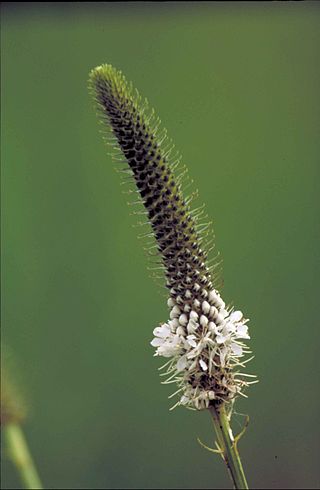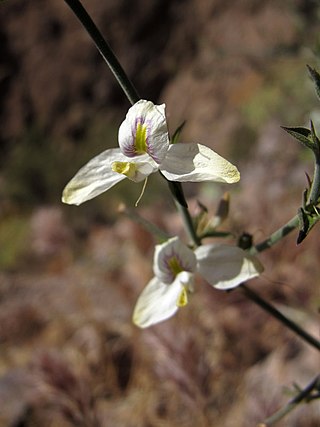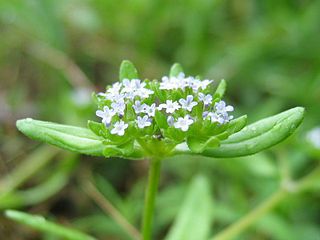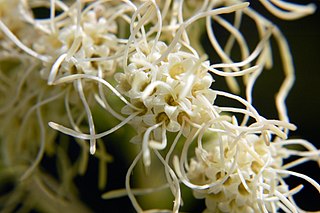
Helianthus is a genus comprising about 70 species of annual and perennial flowering plants in the daisy family Asteraceae commonly known as sunflowers. Except for three South American species, the species of Helianthus are native to North America and Central America. The best-known species is the common sunflower. This and other species, notably Jerusalem artichoke, are cultivated in temperate regions and some tropical regions, as food crops for humans, cattle, and poultry, and as ornamental plants. The species H. annuus typically grows during the summer and into early fall, with the peak growth season being mid-summer.

Palafoxia, or palafox, is a genus of North American flowering plants in the Bahia tribe within the Asteraceae.

Parkinsonia, also Cercidium, is a genus of flowering plants in the pea family, Fabaceae. It contains about 12 species that are native to semi-desert regions of Africa and the Americas. The name of the genus honors English apothecary and botanist John Parkinson (1567–1650).

Rudbeckia is a plant genus in the Asteraceae or composite family. Rudbeckia flowers feature a prominent, raised central disc in black, brown shades of green, and in-between tones, giving rise to their familiar common names of coneflowers and black-eyed-susans. All are native to North America, and many species are cultivated in gardens for their showy yellow or gold flower heads that bloom in mid to late summer.

Dalea is a genus of flowering plants in the legume family, Fabaceae. Members of the genus are commonly known as prairie clover or indigo bush. Its name honors English apothecary Samuel Dale (1659–1739). They are native to the Western hemisphere, where they are distributed from Canada to Argentina. Nearly half of the known species are endemic to Mexico. Two species of Dalea have been considered for rangeland restoration.

Hedeoma is a genus of flowering plants in the mint family, Lamiaceae. It is native to North and South America. They are commonly known as false pennyroyals.

Carlowrightia is a genus of flowering plants in the bear's breeches family, Acanthaceae. Members of the genus, commonly known as wrightworts, are mainly small shrubs bearing inflorescences of lily-like flowers. They are native to the Americas, ranging from the southwestern United States through Mexico and Central America, and in Ecuador. Many species are native to western North America. The genus was named for the American botanist Charles Wright.

Thamnosma is a genus of flowering plants in the rue family, Rutaceae. Plants in this genus are sometimes known by the common name desertrue.

Valerianella is a genus of flowering plant in family Caprifoliaceae. It includes 23 species native to the Mediterranean Basin of southern Europe and North Africa, western and central Asia, Madeira and the Azores, and Ethiopia and Kenya. Many species formerly placed in Valerianella, including those native to the Americas, have been moved to Valeriana. Plants of Valerianella and Valeriana are sometimes known by the common name corn salad or cornsalad.
Texana is a ghost town which was located in Jackson County, Texas, United States, near Edna. The community was one of the earliest Anglo-American settlements in the state. The town flourished as late as 1880, but when the railroad bypassed the town, it rapidly declined. The site was flooded a century later by the Lake Texana reservoir.

Eysenhardtia is a genus of flowering plants in the family Fabaceae. It belongs to the subfamily Faboideae. Members of the genus are commonly known as kidneywoods.

Tetragonotheca is a genus of North American plants in the family Asteraceae. Nerveray is a common name for plants in this genus.

Diospyros texana is a species of persimmon that is native to central, south and west Texas and southwest Oklahoma in the United States, and eastern Chihuahua, Coahuila, Nuevo León, and Tamaulipas in northeastern Mexico. Common names include Texas persimmon, Mexican persimmon and the more ambiguous "black persimmon". It is known in Spanish as chapote, chapote manzano, or chapote prieto, all of which are derived from the Nahuatl word tzapotl. That word also refers to several other fruit-bearing trees.

Thamnosma montana, the turpentine broom, or Mojave desert-rue, is a shrub in the citrus family Rutaceae. It is native to the deserts of the southwestern United States and northern Mexico. Except immediately after heavy rains, its straight stems usually lack leaves, giving it a broom-like appearance. The Latin specific epithet montana refers to mountains or coming from mountains.

Wedelia acapulcensis, commonly known as Acapulco wedelia, is a species of flowering plant in the family Asteraceae. It is native to Texas in the United States, Mexico, and Central America.
Gutierrezia texana is a North American species of flowering plant in the family Asteraceae known by the common name Texas snakeweed. It is native to the south-central United States and northern Mexico as far south as Guanajuato and Hidalgo.
Baccharis texana is a North American species of shrubs in the family Asteraceae known by the common name prairie baccharis or false willow. It is native to northeastern Mexico and to the southern part of the Great Plains of the United States.

Brickellia eupatorioides, or false boneset, is a North American species of flowering plants in the family Asteraceae. It is widespread in Mexico from Chihuahua to Oaxaca, and in all regions of the contiguous United States except New England, New York, and the West Coast.
Eurytaenia is a genus of flowering plants belonging to the family Apiaceae.

Lygodesmia texana, the Texas skeleton plant, is a species of flowering plant in the family Asteraceae, native to the US states of New Mexico, Texas, and Oklahoma, and to northeastern Mexico. A perennial reaching at most 2 ft (60 cm), it prefers to grow on well-drained limestone soil and blooms from April to August.
















